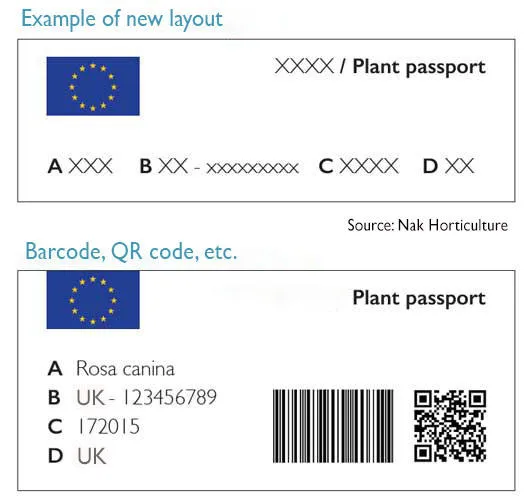On 14 December 2019, the new Plant Health Regulation 2016/2031/EU (PHR) came into effect as a replacement for the Plant Health Directive 2000/29/EC.
What is the plant passport?
The plant passport is intended for all “plants intended for planting”. The plant passport must be applied beginning from the smallest trade unit. This passport is important for the movement of plants within the European Union.
The external appearance of the plant passport is laid down in the Plant Health Regulation 2016/2031/EU (PHR). It is issued in a square or elongated form and consists of a number of fixed elements:
- In the top left-hand corner is the flag of the European Union, in colour or in black and white.
- In the top right-hand corner are the words “Plant passport”.
- The letter “a” followed by the botanical name of the plant species in question.
- The letter “b” followed by the ISO code of the Member State of the producer, followed by a hyphen and the 9-digit phytosanitary registration number.
- The letter “c” followed by the plant's traceability code. This may be supplemented with a QR code, hologram, chip or other data carrier belonging to the traceability code.
- The letter “d” followed by the ISO code of the country of origin or production.
In addition to these fixed elements, you can determine the font type and size yourself. The starting point for these external provisions is that the text in the plant passport must be legible to the naked eye and that it can be distinguished from any other information at a glance.
There are various options for applying the passport to your products. The plant passport can be printed on the plant pot, the index cards, tray, plant label, etc.

Why the plant passport?
Plant health is very important for the production of plants and forests and for natural ecosystems and biodiversity. Because of globalisation of trade and climate change, there is a greater risk of harmful species entering Europe from other countries. The purpose of introducing the plant passport is to provide Europe with greater protection against this threat of pests and diseases.
With the introduction of the plant passport, more attention is also being paid to the traceability of plants. As a result, free trade and access to the European market can be maintained, while limiting the risk to plants of pests and diseases.
How can Domino help you?
Domino enables you to choose from different coding technologies for applying the plant passport to your products. Take, for example, our small character or large character inkjet, thermal transfer printer, thermal Inkjet, laser coding or other printing and labelling technologies. The type of product and soil that you want to code determines which option is best for you.
QuickDesign
A Domino software solution - is a way a single application for designing labels, printing and managing your coding operations allowing faster product setup and reducing rework. This may be a potential solution for managing the challenges surrounding the commercial trading of plants and plant products - for example, you may decide to store the Plant Passport data in a location accessible to QuickDesign (an internal/external product database or provided via a file transfer (MES/ERP)). An inspection audit log could also be produced to assist with keeping a record of any plant passports that are printed. Such project details would depend on your manufacturing environment and variables.
>> Please contact us for more information.